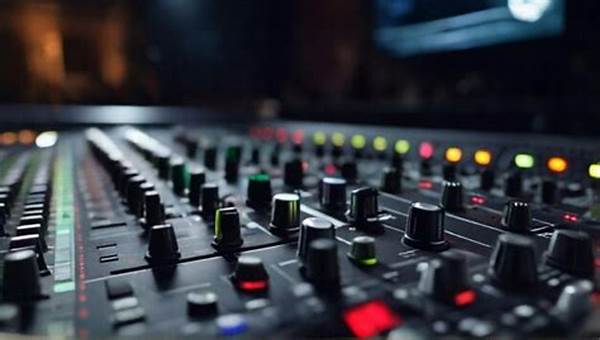In the bustling world of live music, dynamic mixing for live performances is the unsung hero that brings concerts to life. This technique is the process of adjusting audio levels, effects, and other elements in real-time to ensure that the audience experiences the best possible sound. Unlike studio mixing, which can be finessed over time, live mixing demands instant decisions and a keen ear to adapt to the ever-changing dynamics of a live performance. It’s about maintaining the balance, ensuring each instrument and voice shines at the right moment while adapting to the environment’s natural acoustics.
Read Now : Indie Hits Playlist 2023 Festival
The Art of Real-Time Sound Balance
Dynamic mixing for live performances isn’t just about twiddling knobs and pushing faders. It’s an art form, alive with the energy of the show. Picture this: the band hits that crescendo, and as the crowd goes wild, the sound engineer has mere seconds to balance the roar of the guitars against the thunderous drums. With the right dynamic mixing, the drum solo pops, the singers soar, and the bass rumbles like a freight train. Each live gig demands its unique blend, needing the sound engineer to feel the pulse of the crowd, the vibe of the band, and adjust in a heartbeat. It’s like playing an instrument of its own, with adrenaline as the maestro.
Techniques of Dynamic Mixing
1. Riding the Faders: Constantly adjusting levels to ensure each part of the performance is crystal clear. Dynamic mixing for live performances means every second counts.
2. EQ Tweaking: Balancing frequencies to make sure no sound overlaps unpleasantly in the mix.
3. Compression Control: Smoothing out volume spikes so the sound stays tight and clean.
4. Spatial Effects: Using reverb and delay to create a sense of space without muddying up the mix.
5. Feedback Management: Squashing that ear-piercing squeal before it ruins the vibe.
Challenges in Dynamic Mixing
Dynamic mixing for live performances is a rollercoaster of challenges. Imagine pulling off a sonic juggle while the band’s rocking out, and the crowd’s losing it. The room acoustics shift, the lead singer steps away from the mic, and suddenly, a guitar string snaps. It’s about thinking on your feet with the reflexes of a ninja. When tech goes haywire, the show must roll on. Engineers have to be masters of every bit of gear they touch, knowing the rig inside out and backward. In a split second, they must decide which instrument gets the spotlight, which gets dialed back. It’s risky but exhilarating, reminiscent of a high-wire act where everything’s in flux, yet must remain seamless.
Read Now : Innovative Orchestra Performance Techniques
Soundcheck: The Pre-Show Ritual
Before the crowd pours in, dynamic mixing for live performances begins with the soundcheck. This is the backstage magic where engineers fine-tune the levels. It’s like setting the stage for sonic bliss, predicting and ironing out any quirks before showtime. Practicing with the band, identifying potential issues, and locking down the perfect mix. Everything’s got to sound just right, so when those stage lights flick on, and the first note hits, it’s pure perfection. The soundcheck is the groundwork for a killer show, a pre-game ritual that feels like tuning a magical audio orchestra for the wild ride ahead.
Gear and Gadgets Galore
When it comes to dynamic mixing for live performances, gear is king. Picture a cockpit packed with digital mixing boards, compressors, the latest in sound tech wizardry. Engineers have their favorite toys, each piece carefully selected to make the magic happen. There are digital audio workstations that can shape sound waves in ways that blow the mind. The more intuitive the gadget, the better the mix, enabling the sound wizards to tweak tones with mastery. These tools make the difference between muddy mixes and pristine auditory experiences, turning tech into art with the flick of a switch.
Understanding the Crowd’s Pulse
Dynamic mixing for live performances also means reading the crowd like a book, knowing when to push the energy up or pull it back. It’s about feeding off the audience’s vibe and reacting. When the lead guitarist takes on an epic solo, you bring it front and center; when the lead singer whispers those heartfelt lyrics, you drop everything else to let those words resonate through every soul in the room. There’s a dialogue happening between the stage and the sound desk that’s beyond words, making every performance a unique chapter in the live sound storybook.
Summary of Artistic Excellence
Dynamic mixing for live performances is the fusion of tech and artistry, a symphony of sound engineering skills and intuitive understanding of music. It’s about delivering an auditory masterpiece where every chord is in harmony, and every note is a revelation. From the moment the first chord reverberates, the mix must be on point. It’s quick-thinking, about split-second decisions, and knitting it all together seamlessly in real-time. The craft requires finesse, quick reflexes, and a deep connection to the music, bringing the show to life with vibrant clarity.
Whether it’s tiny club gigs or massive stadium spectacles, dynamic mixing for live performances breathes life into the music. It’s the backbone of every concert, ensuring the show resonates perfectly with the audience. Mixing isn’t just a technical process; it’s an art, a passion, and for those few hours on stage, it’s what makes live music unforgettable.
